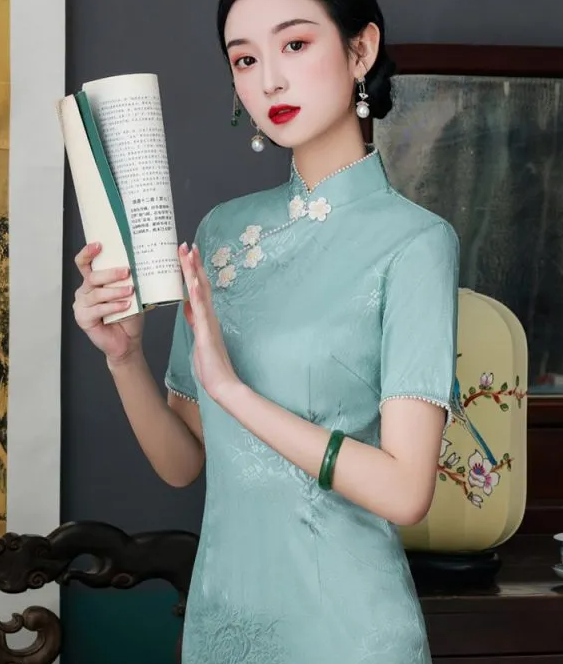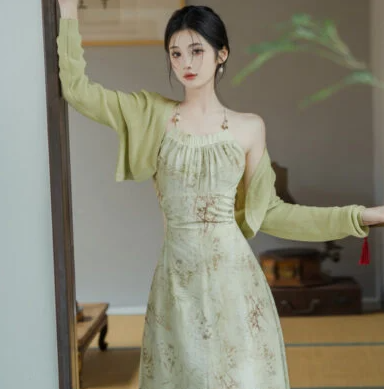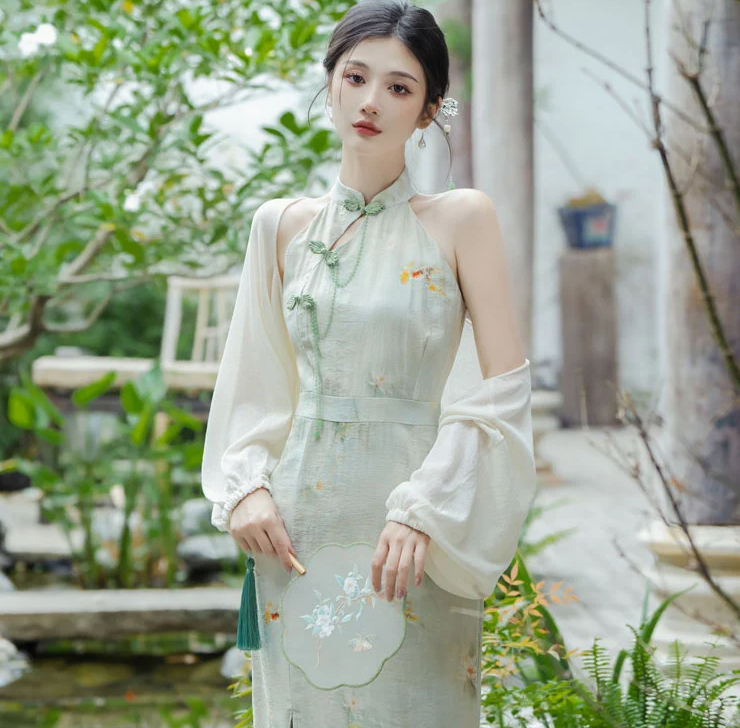Cheongsam types include traditional, modern, wedding, men’s, children’s, and varying accessories.
Introduction to Cheongsam (Qipao)
The Cheongsam, also known as the Qipao, is a traditional Chinese dress that has captured the world’s attention with its elegant design and cultural significance. Hugging the curves of the body, it showcases the grace and beauty of those who wear it. From its origins in the Qing Dynasty to its modern-day renditions, the Cheongsam remains an integral symbol of Chinese femininity and identity.

Brief History
Originally, the Cheongsam was a loose-fitting dress worn by Manchu women during the Qing Dynasty. It underwent significant transformations in the 1920s and 1930s, especially in cosmopolitan cities like Shanghai. The dress evolved from a broad and baggy form to a more fitting and stylish version, in line with the fashion of the era. By the 1950s, with the social and political changes in China, the Cheongsam became less prominent, only to make a resurgence on the international stage in recent years, thanks to global fashion shows and the efforts of designers who value traditional attire. For a deeper dive into its history, one can explore the Wikipedia page on Cheongsam.
Significance in Chinese Culture
The Cheongsam is more than just a dress; it’s a representation of Chinese culture, tradition, and identity. For many, it symbolizes grace, modesty, and the beauty of the Chinese heritage. In various Chinese festivals and ceremonies, such as the Lunar New Year or weddings, the Cheongsam is often the dress of choice, showcasing its deep-rooted significance in Chinese traditions. Moreover, with the rise of Chinese cinema, many iconic scenes feature actresses in Cheongsams, further solidifying its cultural prominence. The dress also serves as a bridge between the old and the new, representing the harmonious coexistence of tradition and modernity in today’s China. For more about its cultural significance, the Wikipedia page on Chinese culture offers a vast array of information.
Traditional Cheongsam
The traditional Cheongsam is a timeless representation of Chinese sartorial elegance. As the quintessential Chinese dress, it reflects the nation’s history, culture, and artistry in its design and craftsmanship.
Origin and Characteristics
The Cheongsam’s roots trace back to the Manchu-ruled Qing Dynasty, when it was worn by women in a looser, more conservative style. Over the decades, particularly in the early 20th century, the dress underwent modifications, embracing a slimmer silhouette. A traditional Cheongsam is distinguished by its high collar, side slits, and an asymmetrical front adorned with intricate frog fastenings. The length, cut, and fit can vary, but its essence remains anchored in its rich historical context. Interested readers can delve deeper into its origins on the Wikipedia page on Cheongsam.
Fabrics and Materials Used
Silk is the most favored material for crafting a traditional Cheongsam, owing to its smooth texture, natural sheen, and the way it elegantly drapes the body. High-quality Cheongsams can cost upwards of $500, with prices varying based on the intricacy of design and quality of silk. Other materials, like cotton or linen, might be used, but silk remains the most sought-after. The dress often showcases exquisite embroideries, featuring motifs like dragons, phoenixes, and floral patterns, each carrying its symbolic meaning in Chinese culture.
Occasions for Wearing
While the Cheongsam can be worn casually today, traditionally, it was reserved for special occasions. Festivals, family reunions, and weddings were prime events where women showcased their finest Cheongsams. In particular, during the Lunar New Year, wearing a new Cheongsam symbolized a fresh start and good fortune. The dress also played a pivotal role in formal gatherings, signifying the wearer’s cultural pride and sophistication. For those interested in the various festivities and ceremonies in China, the Wikipedia page on Chinese festivals offers a comprehensive overview.
Modern Cheongsam
As fashion trends evolve and societies progress, the Cheongsam has also undergone transformations. The modern Cheongsam, while preserving its foundational aesthetics, incorporates contemporary touches that make it adaptable to the changing times.
Evolution and Adaptations
From its traditional silhouette, the modern Cheongsam has seen adaptations to suit today’s fashion-forward audience. Designers have played with the dress’s length, often introducing shorter versions more suitable for casual outings or summer days. The iconic high collar, while still present in many designs, has been lowered or sometimes even removed to provide a fresher look. Another notable change is the inclusion of zippers for convenience, as opposed to the traditional frog fastenings. For an extensive understanding of its evolution, the Wikipedia page on Cheongsam offers a trove of information.
Modern-day Fabrics and Patterns
While silk continues to be a popular choice for Cheongsams, modern versions have embraced a range of materials, including velvet, chiffon, and even synthetic blends. These materials often come at a lower cost, with modern Cheongsams available in the range of $100 to $800, depending on the design intricacy and fabric quality. Patterns too have seen a shift. While traditional motifs like dragons and phoenixes remain popular, abstract designs, geometric patterns, and even digital prints lend a modern flair to the attire.
Popular Styles and Cuts
In sync with global fashion trends, the Cheongsam now comes in a variety of styles and cuts. Some popular ones include:
- Sleeve Variations: From sleeveless to bell sleeves, the options are vast and varied.
- Hemline Play: From knee-length cuts for a chic look to ankle-length versions for formal events, the modern Cheongsam offers a style for every occasion.
- Neckline Innovations: Beyond the traditional high collar, V-necks and round necklines offer alternatives for those seeking a twist to the classic style.

Wedding Cheongsam
Weddings are significant events marked by rituals, emotions, and splendor. In Chinese traditions, the Cheongsam plays a pivotal role, especially when it comes to nuptial ceremonies. The wedding Cheongsam, often opulent and crafted with immense attention to detail, stands out as a symbol of love, commitment, and cultural pride.
Significance in Chinese Weddings
In Chinese weddings, the Cheongsam is more than just a dress; it’s a reflection of ancestry, familial ties, and blessings for the couple’s future. Often, brides opt for a Cheongsam as a second outfit for the tea ceremony—a ritual where the newlyweds serve tea to their elders as a sign of respect and gratitude. Wearing a Cheongsam signifies the embrace of cultural values and imparts wishes of prosperity, love, and longevity. The Wikipedia page on Chinese weddings provides a deeper understanding of the various customs and their significance.
Designs and Embellishments
Wedding Cheongsams are a league apart in their designs. The primary color for brides is typically red, considered auspicious and symbolic of luck and happiness. Embellishments are painstakingly detailed, often with gold threading, to signify wealth and prosperity. Motifs like the phoenix, dragon, and peony flowers, representing love and harmony, are commonly embroidered onto the dress. Depending on the intricacy of the design, a high-quality wedding Cheongsam can range from $1,000 to over $5,000.
Custom-made vs Ready-to-wear
- Custom-made: Many brides opt for custom-made Cheongsams to ensure a perfect fit and personal touch. These dresses are tailor-made, factoring in the bride’s preferences, from the choice of fabric to specific embellishments. Customization allows for a unique dress that holds personal significance, though it may come at a higher price, often starting at $2,000 and can go up depending on the materials and design intricacies.
- Ready-to-wear: For those on a tighter schedule or budget, ready-to-wear options are available. These dresses are pre-made in standard sizes and often cost less, ranging from $300 to $1,500. The advantage lies in convenience and speed, though one might sacrifice the uniqueness and personalized touch of a custom-made dress.
Cheongsam for Men
While the Cheongsam, or Qipao, is most commonly associated with women, there’s a version tailored explicitly for men that carries its own history and style. Men’s Cheongsam offers a fascinating juxtaposition of traditional aesthetics and evolving fashion preferences.

Historical Background
The origin of the men’s Cheongsam dates back to the early Qing Dynasty when it was standard attire for the Manchu men. During this period, the dress was typically long, loose, and adorned with a mandarin collar, reflecting the modesty and formality of the time. With the rise of the Republic of China, the men’s Cheongsam underwent significant transformations, aligning more with Western-style suits while maintaining its distinct collar and frog fastenings. This mix of East and West made the attire popular among intellectuals and urban elites. A deeper dive into its history can be explored on the Wikipedia page about Cheongsam.
Modern Interpretations and Styles
Today’s men’s Cheongsam showcases a blend of traditional elements with contemporary fashion sensibilities. Some prevalent trends include:
- Simplified Designs: Modern versions lean towards minimalism, often featuring plain fabrics with subtle embroidery or patterns.
- Versatility in Length: While the traditional design was long, modern versions vary from long to short, suitable for both formal events and casual outings.
- Material Exploration: Beyond the conventional silk, contemporary designs incorporate materials like linen, cotton, and even synthetic blends, offering a variety in texture and price points, with prices ranging from $150 to $1,000 based on the material and design.
Differences from Women’s Cheongsam
- Fit and Silhouette: Men’s Cheongsams are generally straight-cut, unlike the body-hugging silhouette of women’s versions. This provides a more relaxed fit, suited for male body structures.
- Decorative Elements: Men’s designs are often more restrained in terms of decorative elements, avoiding excessive embroidery or flamboyant patterns.
- Functional Additions: Many modern men’s Cheongsams incorporate functional elements like pockets, making them more practical for everyday wear.
Children’s Cheongsam
The elegance and charm of the Cheongsam are not reserved just for adults; children too can indulge in this beautiful piece of Chinese heritage. The children’s Cheongsam, tailored to cater to the whimsicality and vibrant spirit of youth, manages to be both delightful and deeply rooted in tradition.
Designs Suitable for Younger Wearers
Children’s Cheongsams are often crafted with comfort and mobility in mind. Recognizing that kids love to move, jump, and play, these garments incorporate:
- Soft Fabrics: Materials like cotton and soft silk ensure comfort. While silk versions might cost between $50 to $150, cotton ones can be priced as low as $20.
- Easy Closures: Instead of intricate knots and closures, many children’s Cheongsams use simpler button mechanisms or zippers.
- Wider Cuts: These are designed for ease of movement, ensuring kids can play without feeling restricted.

Occasions and Celebrations
The Cheongsam for children is especially popular during specific events and festivals:
- Chinese New Year: One of the most anticipated occasions, children adorned in bright and colorful Cheongsams add to the festivity’s vibrancy.
- Mid-Autumn Festival: As families gather to celebrate and share mooncakes, many children dress in Cheongsams to mark the tradition.
- Birthday Celebrations: Especially for milestone birthdays, parents might dress their children in Cheongsams as a nod to heritage and culture. More about Chinese birthday traditions can be read on Wikipedia.
Trends and Popular Motifs
Children’s Cheongsams often feature designs that appeal to their imagination and preferences:
- Animal Motifs: Commonly seen are pandas, cranes, and goldfish, symbolizing various virtues and adding a touch of playfulness.
- Floral Patterns: Blooms like peonies and chrysanthemums, which stand for prosperity and joy, frequently adorn these dresses.
- Bright Colors: While red remains popular, children’s Cheongsams come in a range of bright and lively colors, including pinks, yellows, and blues.
Accessories with Cheongsam
The Cheongsam, with its exquisite design and attention to detail, often stands out on its own. However, like all iconic dresses, it gets elevated further when paired with the right accessories. Whether you’re aiming for a look steeped in tradition or one that marries contemporary style with classic design, the right accessories can make all the difference.
Traditional Accessories (Shoes, Jewelry, etc.)
When it comes to traditional accessories, the intent is to accentuate the Cheongsam’s inherent elegance without overpowering its beauty:
- Shoes: Traditionally, women paired Cheongsams with soft-soled cloth shoes, typically in black or white. These shoes, known as Mary Janes, complement the Cheongsam’s classic design. Depending on the intricacy and material, these shoes can range from $20 to $100.
- Jewelry: Jade bangles and earrings have been a perennial favorite. Jade symbolizes purity and protection in Chinese culture. A quality jade bangle might be priced anywhere from $100 to $2,000, depending on its quality and design.
- Hairpieces: Ornamental hairpins made of silver or adorned with pearls and gemstones were common. They not only beautified the hairdo but also signified status and wealth.
For more insights on traditional Chinese jewelry, you can explore this Wikipedia link.
Modern Complements and Pairings
Modern fashionistas often love to experiment, blending the Cheongsam’s timeless design with contemporary accessory trends:
- Shoes: High heels, especially those with ankle straps or minimalist designs, are now a popular choice. Prices vary widely, from affordable $30 pairs to luxury brands costing $1,000 or more.
- Bags: Clutches or small handbags with geometric designs or metallic finishes add a touch of modern chic to the Cheongsam. Depending on the brand and material, these can range from $50 for basic designs to $5,000 for luxury brands.
- Jewelry: While jade remains popular, many now opt for minimalist gold or silver necklaces, earrings, and bracelets. Statement pieces, especially necklaces, can also elevate the outfit’s contemporary feel.